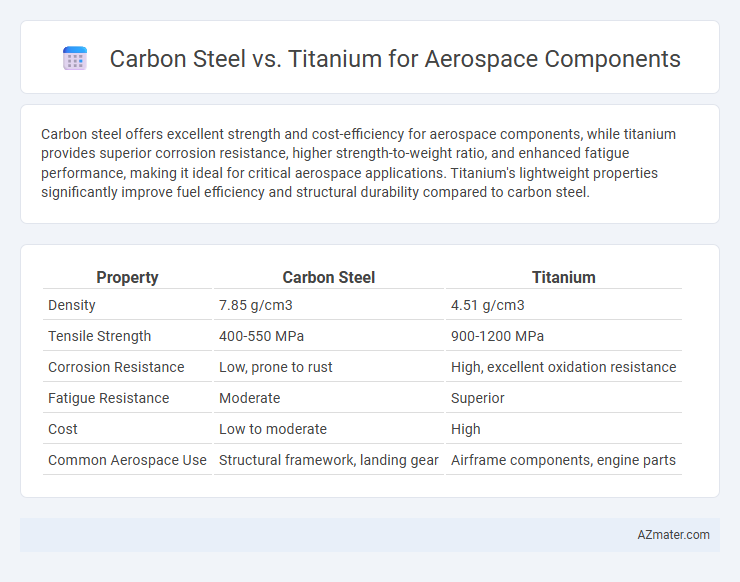Carbon steel offers excellent strength and cost-efficiency for aerospace components, while titanium provides superior corrosion resistance, higher strength-to-weight ratio, and enhanced fatigue performance, making it ideal for critical aerospace applications. Titanium's lightweight properties significantly improve fuel efficiency and structural durability compared to carbon steel.
Table of Comparison
| Property | Carbon Steel | Titanium |
|---|---|---|
| Density | 7.85 g/cm3 | 4.51 g/cm3 |
| Tensile Strength | 400-550 MPa | 900-1200 MPa |
| Corrosion Resistance | Low, prone to rust | High, excellent oxidation resistance |
| Fatigue Resistance | Moderate | Superior |
| Cost | Low to moderate | High |
| Common Aerospace Use | Structural framework, landing gear | Airframe components, engine parts |
Introduction to Aerospace Material Selection
Carbon steel offers high strength and affordability but suffers from higher weight and corrosion susceptibility compared to titanium, which provides exceptional strength-to-weight ratio and corrosion resistance critical for aerospace applications. Titanium's biocompatibility and fatigue resistance make it ideal for structural aerospace components requiring durability under extreme conditions. Selecting between carbon steel and titanium depends on balancing factors like mechanical properties, weight limitations, cost constraints, and environmental exposure in aerospace engineering.
Overview of Carbon Steel in Aerospace
Carbon steel is extensively used in aerospace components due to its high strength, durability, and cost-effectiveness, making it ideal for structural parts and fasteners. Its excellent machinability and weldability allow for versatile manufacturing processes, while carbon steel's fatigue resistance supports the demanding operational cycles of aircraft. Despite being heavier than titanium, carbon steel offers superior toughness and is widely preferred where weight constraints are less critical.
Overview of Titanium in Aerospace
Titanium in aerospace is highly valued for its exceptional strength-to-weight ratio, corrosion resistance, and ability to withstand extreme temperatures, making it ideal for critical components such as airframe structures, engine parts, and fasteners. Unlike carbon steel, titanium offers significant weight savings, which enhances fuel efficiency and overall aircraft performance. Its biocompatibility and resistance to fatigue also contribute to longer service life and reduced maintenance costs in aerospace applications.
Mechanical Properties: Strength and Weight Comparison
Titanium offers a superior strength-to-weight ratio compared to carbon steel, making it ideal for aerospace components requiring high strength with minimal weight. Carbon steel exhibits higher density, resulting in heavier components that can reduce fuel efficiency and payload capacity. Titanium's exceptional tensile strength combined with low density enhances performance and durability in aerospace applications.
Corrosion Resistance: Carbon Steel vs Titanium
Titanium exhibits superior corrosion resistance compared to carbon steel, making it ideal for aerospace components exposed to harsh environments and moisture. Carbon steel is prone to rust and requires protective coatings or treatments to prevent corrosion, increasing maintenance needs and weight. The exceptional corrosion resistance of titanium enhances durability and longevity, reducing lifecycle costs in aerospace applications.
Fabrication and Machinability Differences
Carbon steel offers superior machinability due to its higher hardness and availability of diverse grades tailored for ease of fabrication, making it cost-effective for aerospace components. Titanium, while more challenging to machine because of its low thermal conductivity and tendency to work harden, provides excellent corrosion resistance and strength-to-weight ratio essential for aerospace applications. Fabrication of titanium requires specialized tools and techniques such as controlled cutting speeds and coolants to prevent material damage and ensure precision in complex aerospace parts.
Cost Analysis in Aerospace Applications
Carbon steel offers a significantly lower initial material cost compared to titanium, making it a budget-friendly choice for aerospace components requiring moderate strength and durability. Titanium, despite its higher price, provides exceptional strength-to-weight ratio and corrosion resistance, which reduces maintenance costs and extends component lifespan in aerospace applications. Lifecycle cost analysis often favors titanium for critical components due to its superior performance and reduced long-term expenses, outweighing its upfront cost disadvantage.
Performance in Extreme Environments
Titanium exhibits superior corrosion resistance and strength-to-weight ratio compared to carbon steel, making it ideal for aerospace components exposed to extreme temperatures and corrosive environments. Carbon steel, while strong and cost-effective, often requires protective coatings to withstand oxidative degradation and lacks the fatigue resistance of titanium under cyclic stress. The high specific strength and thermal stability of titanium alloys enable enhanced durability and reliability in aerospace applications subjected to rigorous mechanical and environmental demands.
Sustainability and Lifecycle Considerations
Carbon steel offers high strength and affordability but has a higher environmental impact due to carbon emissions during production and shorter lifespan caused by corrosion. Titanium, though more energy-intensive to extract and process, provides superior corrosion resistance, weight reduction, and longer service life, leading to better sustainability in aerospace components over their lifecycle. Lifecycle assessments highlight titanium's potential for reduced maintenance and recycling benefits, ultimately lowering total environmental footprint compared to carbon steel.
Conclusion: Choosing the Right Material for Aerospace Components
Titanium offers superior strength-to-weight ratio and corrosion resistance, making it ideal for critical aerospace components requiring durability and weight reduction. Carbon steel provides excellent cost-effectiveness and machinability but lacks the lightweight and anti-corrosive properties necessary for advanced aerospace applications. Selecting the right material depends on balancing performance requirements, budget constraints, and specific component functions within the aerospace design.

Infographic: Carbon steel vs Titanium for Aerospace component
 azmater.com
azmater.com